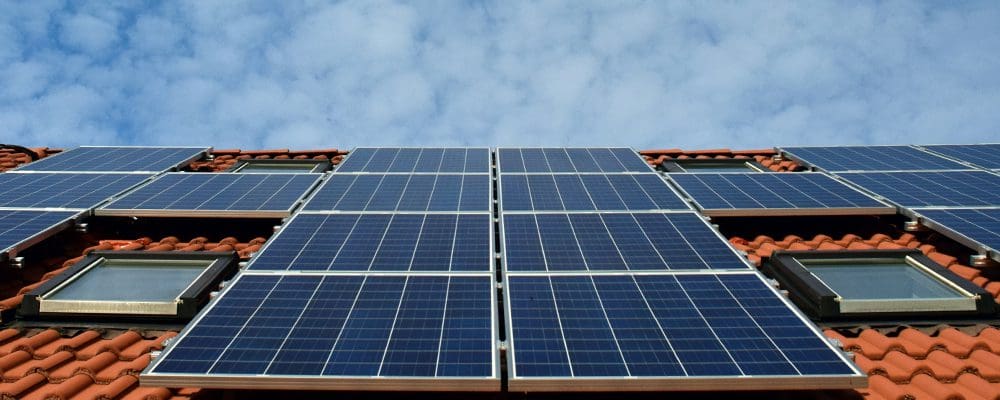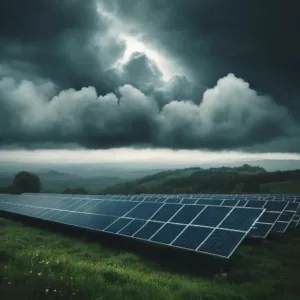Thinking about putting solar panels on your home? Solar is green! Solar will reduce your energy"Energy" is a fundamental concept in physics, often described as the ability to do work or cause change. In everyday terms, it's what is needed to move things, heat them... bills! Solar is good for the environment! Solar reduces reliance on fossil fuels! Solar is cool! Right?!
Well, yes, harvesting energy from the sun can be an ‘earth-friendly’ alternative fuel, but is there more to the story? In this post, we’re going to look at what solar panels really are, and explore the not-so-often discussed downsides of using them on your home.
I’m certainly not writing this with the intent of bashing alternate energy sources. I definitely believe we need to reduce our energy consumption and invest in cleaner, smarter, and more earth-friendly technology. However, it’s important for us to know exactly what we’re getting when investing in such sources. As with most things, there is often more to the story than what’s on the surface.
What Are Solar Panels?
First, let’s explain exactly what solar energy is, or more specifically, solar panels.
Solar panels are photovoltaic cells that are made primarily of silicon, aluminum and glass. You’ve probably used a calculator with a tiny solar panel at the top, or maybe you’ve seen the large panels on the roof of people’s homes. These cells absorb the sunlight, and the light causes the silicon atoms inside the cells to move. The moving electrons travel along the aluminum and a direct current"Direct Current" (DC) is a type of electrical current where the electric charge flows consistently in one direction. It's like water flowing steadily in a straight line through a hose.... (DC) of electricity is formed.
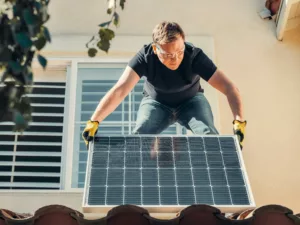
Next, that direct current must be converted to an alternating currentFundamentals of Alternating Current Alternating current (AC) is a type of electrical current in which the flow of electric charge periodically reverses direction. In contrast to direct current (DC) where... (AC) to power"Power" in a scientific context refers to the rate at which work is done or energy is transferred. In simpler terms, it's how fast something is using energy. For example,... the devices inside your home. This is done by a DC to AC inverter.

Want to Slash Your EMF Health Risks?
Want to Slash Your EMF Health Risks?
Good! Learn the one small change you should make right now.
There are a number of different type of solar power inverters. Some operate at the level of each individual panel (called microinverters), while other systems have inverters for each row of panels (string inverters) or centrally for the entire system. You can also get hybrid battery-inverters that both convert and store energy.
The Advantages of Using Solar Power
There are several benefits of using solar panels.
1. Financial savings. Though solar panels are an expensive investment upfront, you will generally see a reduction in your monthly utility bills. How much you save depends on several factors like how many panels you have, how sunny it is where you live, and how much energy you consume. On average, you should expect to see a complete return on your investment in about 7-12 years, with continued savings for the 25-year expected lifespan of the system.
2. Increased home value. Increased demand for ‘green’ energy makes homes with existing solar panels very attractive. Depending on where you live, you can expect a property value increase of roughly 2-5%.
3. Good for the environment. Solar produces ‘clean’ energy without the use of hazardous emissions from fossil fuels, thus lowering greenhouse gases. This is good for both the health of the planet, and for the health of people.
Sounds pretty great right? Those are all things that most of us could get behind. But are there downsides?
The Disadvantages of Using Solar Power
In fact, there are several disadvantages to having solar panels on your home.
1. Upfront costs. Like I mentioned above, most solar panel owners eventually see a reduction in their utility bills. But, there is an approximate upfront cost of anywhere from $10,000 to $27,000. That high upfront cost will be out of reach for many homeowners.
2. Not efficient in cloudy environments. Solar panels obviously work well in sunny climates like Colorado and Arizona, but what about places like Portland OR, and Seattle WA? While you will generate some energy in these cloudy climates, the financial return on your investment will take years longer, if at all.
3. Environmental impacts. Wait! Didn’t I say they were good for the environment? They do help with reducing greenhouse gases, but they are not without their own environmental issues. In order to make the panels, hazardous chemicals are used to clean the semiconductor surfaces. These chemicals may include acetone, hydrogen fluoride, sulfuric acid, trichloroethane and others. In the case of large-scale solar plants, large parcels of land must be cleared and can threaten wildlife habitat. And finally, the manufacturing process itself utilizes significant resources like water, fuel, transportation and chemicals.
4. Health impacts. It will probably come as a surprise to most people that having solar panels on their homes can cause serious health issues. Because the energy created must be converted from DC to AC, dirty electricity can be created and put on the home’s electrical wires.
Many of the issues can be debated. Yes, there is an environmental impact in creating the panels, but over the lifespan of the system, the amount of greenhouse gases saved may outweigh the initial impact. The financial cost upfront can be prohibitive for some, but if you live in the home for at least 10-12 years, you will eventually come out ahead.
Many will even debate whether or not the impact on your health is real. Critics will say there is no scientific evidence showing there is a biological impact. For me, understanding if there are health implications is the most important consideration. While I’m a big fan of conserving energy and using more ‘earth-friendly’ energy sources, it is simply not worth risking the health of my family. So, let’s take a deeper dive into what the scientific literature actually says.
Are Solar Panels Bad For Your Health?
In order to answer this question, remember that solar panels create direct current, which must be converted to alternating current in order to power your home’s electricity and appliances. The system’s inverter takes the low-voltage, high-current signals and converts them to 120-volt or 240-volt alternating current. It’s this conversion that creates what we call ‘Microsurge Electrical Pollution’ or ‘Dirty Electricity’ (DE).
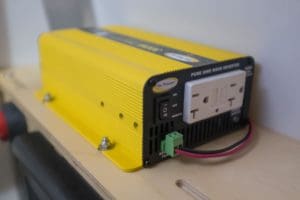
Dirty electricityDirty Electricity, also known as electrical pollution, refers to the presence of irregularities or distortions in the normal electrical current within a wiring system. These distortions, which deviate from the... is considered one of the four main fields that a Building Biologist or other EMF consultant would be concerned about in your home. In addition to testing your home for radio frequencyRadio Frequency (or RF), a subset of EMF, encompasses electromagnetic wave frequencies ranging from about 3 kilohertz (kHz) to 300 gigahertz (GHz). These frequencies are extensively used in modern wireless..., electric fields, and magnetic fieldsDefinition and Nature of Magnetic Fields Magnetic fields are a fundamental aspect of electromagnetic fields, produced by moving electric charges (electric currents). The strength of a magnetic field is measured..., the consultant will spend a significant amount of time measuring your DE fields as they can be among the most biologically harmful.
DE is also referred to as ‘hash’, ‘noise’, ‘electromagnetic interference’, ‘dirty power’, ‘transients’, and other terms. It’s essentially an altered sine waveThe term "wave" in the context of Electromagnetic Fields (EMF), frequency, and energy is a fundamental concept in physics and essential in understanding various natural phenomena and technological applications. A... on your 50 or 60Hz AC power line (50Hz in Europe and 60Hz in the US.) Harmonics"Harmonics" in the context of waves and Electromagnetic Fields (EMF) is a complex yet fundamental concept in physics and electrical engineering. The term originates from the field of music, where... or frequencies outside of the 50-60Hz standard cycle is considered dirty electricity.
If you’re reading this blog, then you’ve likely heard of electromagnetic fields (EMF) causing health issues for some people. Again, when we talk about EMF radiation"Radiation" in the context of Electromagnetic Fields (EMF) refers to the process by which energy is emitted and transmitted through space or a material medium in the form of electromagnetic..., we’re talking about electromagnetic fields that come from electric fieldsDefinition and Nature of Electric Fields Electric fields are a fundamental aspect of electromagnetic fields, created by electric charges, either stationary or moving. These fields represent the force that electric..., radiofrequency, magnetic fields, and of course, dirty electricity. In my experience, DE has been the most underappreciated and misunderstood of the four main fields. When I’m working with a very sensitive client, it’s very often the DE that is causing the most symptoms.
Solar Energy and EHS
People who experience electrohypersensitivity (EHS) report a variety of different symptoms like headaches, tinnitus, insomnia, muscle weakness, anxiety, depression, cramping, irritability, memory issues, cognitive decline, and many others. While these people are often labeled as being ‘hyper-sensitive’, it does not mean that they are the only ones being affected. The human body is an electric being. It communicates via its own electric signals. When we expose the body to non-native electric signals like EMFs, then that communication can be disrupted.
I don’t want to spend too much time here explaining exactly how EMF radiation affects us on a cellular level, but if you want to dig into this a bit deeper, I suggest checking out the work of Dr. Martin PallDr. Martin Pall, born on July 22, 1943, is a distinguished scientist renowned for his pioneering research in the field of electromagnetic fields (EMF) and their impact on health, particularly.... See his YouTube channel here.

From Dr. Pall’s work and others, we know that EMF radiation affects our biology acutely. Like with many things, some people are more affected by this than others. Those who are ‘hyper’ sensitive, can feel the effects of EMF immediately, and the symptoms can be debilitating. The interesting thing is that some sensitive people will react more strongly to radio frequency"Frequency" in the context of electricity, Electromagnetic Fields (EMF), and wireless communication, can be thought of as the number of times something happens in a second. Specifically, it refers to..., while others react the most severely to magnetic fields, still others react to electric fields, and some people will have the most problems with dirty electricity.
We don’t really know why people react differently to different fields. Anecdotally, however, the most sensitive people I know react the most severely to DE as I mentioned above. And then there are numerous people who are having EHS symptoms, but they haven’t made the connection that their problems are caused by these frequencies!
The Health Effects of Dirty Electricity
While Dr. Pall’s work focuses on how EMFs affect the cells on a general level, what about DE specifically? Thanks to the work of Dave Stetzer and Sam Milham, there has been significant research in this area. They have found that DE can increase behavior and attention issues; there is a correlation between DE and cancer diagnosis’ as well as with Chronic Fatigue Syndrome; chronic stress and neurotransmitter issues can be influenced by DE; DE can negatively impact blood sugar response, and a lot more. Even without this research, I have witnessed among my clients how much DE can impact a person’s health.
I wanted to point this out, because it’s an important thing to understand when you’re considering bringing new items into your home. Maybe you already have your Internet hardwired and keep your phone on airplane mode. There is a lot of awareness around these issues already, but not so much with things like energy-saving appliances and solar panels.
So the big question is, how much dirty electricity does solar emit, and is it enough to impact my health?
How Much EMF Radiation Do Solar Panels Emit?
How much EMF radiation – in the form of dirty electricity – solar panels emit will vary. There are many considerations like the size of the panel, how many panels there are, how much sun is present, other sources of DE inside the home, how efficient the inverter is, etc. There is no way for anyone to say, solar panels give off xx amount of dirty electricity. You have to account for all the variables, and measure with a variety of DE meters.
When I measure DE inside a home I use a Graham Stetzer meter, a Greenwave Meter, an Owon Oscilloscope, and Picoscope. This combination of meters will give me measurements in different frequencies and the oscilloscope and Picoscope will show a visual representation of the amount of DE. Measuring is the only way to know how much DE you have in your home.
So then, how can we know if solar panels will cause a problem for us before we ever install them?
Let me offer you a bit of reference here. I almost always see elevated levels of DE in people’s homes. Often the source is an LED or CFL lightbulb. Using my oscilloscope, I first like to measure inside the home with everything turned off. Here is a picture of my scope in a recent survey I completed. Note the form of the yellow sine wave. That’s more or less how we like it to look. A nice, smooth, thin wave going up and down.
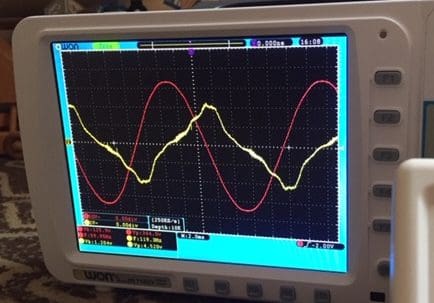
Next I began to turn things on in the house to see if that sine wave changed at all. This is what happened when I turned on one fluorescent lightbulb.
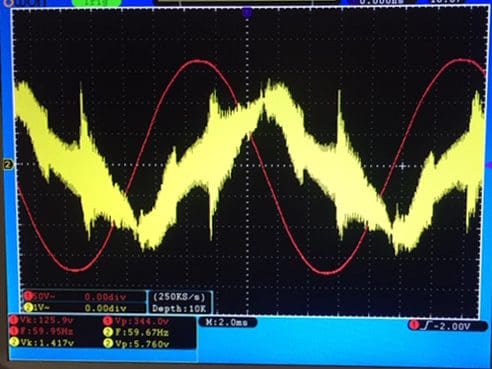
This is quite a significant increase in the dirty electricity. You can definitely expect that to cause health issues. And remember, this was just ONE lightbulb! I see the same thing with computer chargers, LED lights, TVs, and pretty much all energy-saving appliances. If very small devices can contribute so significantly, then I guarantee you that solar panels will have a much more significant impact given the amount of DC to AC conversion they must complete.
In fact, this is exactly what we see when we test solar. A colleague of mine named William Holland (an excellent EMF-aware electrician in Southern California – check out his informative website here) took these pictures of his Picoscope while testing a home with a TeslaThe "tesla" is a unit of measurement in the International System of Units (SI) used to quantify the strength of a magnetic field. Named after the inventor and electrical engineer... Powerwall (a type of battery storage for solar power) that utilizes solar panels. This is what the home’s sine wave looked like with the Powerwall off:
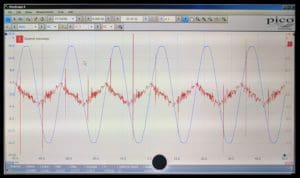
And here is what it looks like with the Powerwall turned on:
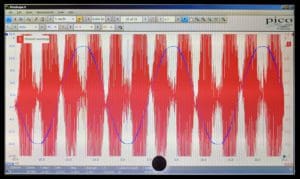
Note that on top of the Powerwall, Tesla recently announced the release of their own Tesla brand inverter. A unique feature of the Tesla inverter is over-the-air updates – meaning the device’s software can be updated on the fly via Wi-Fi, Ethernet or cellular connectivity – as well as app connectivity for power management. So there’s a whole spectrum of EMF being emitted by devices like Tesla’s on top of the dirty electricity.
While I don’t have any read-outs from the Tesla inverter at this stage, it would be interesting to test.
Another colleague of mine, Dave Green, who lives in Michigan captured this image on his Oscilloscope from his own home’s solar panels that use microinverters.
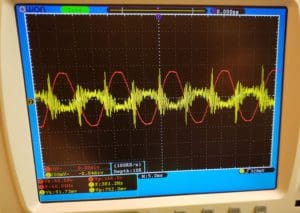
And finally, if you want to see this in action, I suggest you watch these videos taken by Building Biologist Eric Windheim in Sacramento.
Solar Panels & EMF: What Should You Do?
I believe these pictures and videos speak for themselves. There is no doubt that solar panels add an extreme level of DE to your home’s wiring. And knowing what we know about the biological impacts of DE, this is simply not a risk I’m willing to take. I have clients that insisted on installing solar even after I explained the concerns to them. For various reasons they thought they could handle the DE, largely because they didn’t feel as though they were sensitive. Sadly, they became sensitive after living with the elevated levels after just a few weeks.
Now, I should say that this hasn’t happened with everyone. Certainly there are people that have solar panels on their homes and they are seemingly quite healthy and don’t exhibit any EHS symptoms. That’s obviously a very good thing. I just hope they don’t develop symptoms or health problems at some point in the future.
I should also note that there are some companies out there that claim to do solar the ‘right way’ to minimize this DE issue. So far I haven’t seen this to be true. I personally have not tested homes with these filters, but I have colleagues that have. They have reported the same levels of DE and associated health symptoms as other solar systems.
In conclusion, it’s an unfortunate fact that solar panel systems do create extreme levels of EMF in the form of dirty electricity. While you may not feel the health effects from it directly, it doesn’t mean that it’s not impacting you. While I personally try to practice energy-saving behaviors as much as possible, I do so by reducing my consumption of electricity, rather than using energy-saving devices. The risks simply are not worth it.
With the increasing awareness of EMFs and the health implications involved, it is my hope that manufacturers of ‘green’ technology will begin to account for this issue in the near future. Meanwhile, I will continue to turn off breakers at night, use electricity sparingly, and enjoy the ambience of reading by candlelight.
If you’d like to learn more about the potential health impact of your solar power system, schedule a time with a certified EMF consultant right here.
